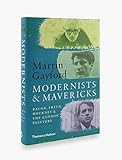Modernists & mavericks : Bacon, Freud, Hockney & the London painters / Martin Gayford.
Material type: TextLanguage: eng Publisher: London : Thames & Hudson Ltd, 2018Copyright date: ©2018Edition: Reprinted 2018Description: 352 pages : illustrations, photographs ; 25 cmContent type: text Media type: unmediated Carrier type: volumeISBN: 9780500239773 (hardback)Subject(s): Bacon, Francis, 1909-1992 | Freud, Lucian | Hockney, David | Painting, English, -- England -- London -- 20th century | Intellectual life | Painting | London (England) -- Intellectual life -- 20th century | London (England)LOC classification: ND470 .G39 2018
TextLanguage: eng Publisher: London : Thames & Hudson Ltd, 2018Copyright date: ©2018Edition: Reprinted 2018Description: 352 pages : illustrations, photographs ; 25 cmContent type: text Media type: unmediated Carrier type: volumeISBN: 9780500239773 (hardback)Subject(s): Bacon, Francis, 1909-1992 | Freud, Lucian | Hockney, David | Painting, English, -- England -- London -- 20th century | Intellectual life | Painting | London (England) -- Intellectual life -- 20th century | London (England)LOC classification: ND470 .G39 2018| Item type | Current library | Shelving location | Call number | Status | Date due | Barcode |
|---|---|---|---|---|---|---|
| Books | MEF Üniversitesi Kütüphanesi | Genel Koleksiyon | ND 470 .G39 2018 (Browse shelf (Opens below)) | Available | 0020251 |
Browsing MEF Üniversitesi Kütüphanesi shelves, Shelving location: Genel Koleksiyon Close shelf browser (Hides shelf browser)

|

|

|

|

|

|

|
||
| ND 259 .K33 B8713 2018 Frida Kahlo : 'I paint my reality' / | ND 450 .B45 1990 Kaynak ve kökleriyle Avrupa resim sanatı : gelişim ve degişim sureci içinde başlangıcından Rönesans sonuna / | ND 467.5 .P7 R6319 2020 Ön Raffaellocular : 500 görsel eşliğinde yaşamları ve eserleri : en önemli eserlerinden 290'ı aşkın örnekten oluşan galeri ile ön Raffeollocuların yaşamları ve sanatlarının resimli açıklaması / | ND 470 .G39 2018 Modernists & mavericks : Bacon, Freud, Hockney & the London painters / | ND 470 .G39 2019 Modernists & mavericks : Bacon, Freud, Hockney & the London painters / | ND 497 .B16 D413 2021 Francis Bacon : the logic of sensation / | ND 497 .B16 H3819 2017 İşte Bacon / |
Includes bibliographical references (pages 344-345) and index(348-352).
1. Young Lucian: Art in Wartime London.
2. Pope Francis.
3. Euston Road in Camberwell.
4. Spirit in the Mass: the Borough Polytechnic.
5. Girl with Roses.
6. Leaping into the Void.
7. Life into Art: Bacon and Freud in the 1950s.
8. Two Climbers Roped Together.
9. What Makes the Modern Home so Different?.
10. An Arena in which to Act.
11. The Situation in London, 1960.
12. The Artist Thinks: Hockney and his Contemporaries.
13. The Grin without the Cat: Bacon and Freud in the 1960s.
14. American Connections.
15. Mysterious Conventionality.
16. Portrait Surrounded by Artistic Devices.
17. Shimmering and Dissolving.
18. The Non-Existence of Acton.
Martin Gayford’s masterful account of painting in London from the Second World War to the 1970s, illustrated by documentary photographs and the works themselves
The development of painting in London from the Second World War to the 1970s has never before been told before as a single narrative. R. B. Kitaj’s proposal, made in 1976, that there was a “substantial School of London” was essentially correct but it caused confusion because it implied that there was a movement or stylistic group at work, when in reality no one style could cover the likes of Francis Bacon and also Bridget Riley.
Modernists and Mavericks explores this period based on an exceptionally deep well of firsthand interviews, often unpublished, with such artists as Victor Pasmore, John Craxton, Lucian Freud, Frank Auerbach, Allen Jones, R. B. Kitaj, Euan Uglow, Howard Hodgkin, Terry Frost, Gillian Ayres, Bridget Riley, David Hockney, Frank Bowling, Leon Kossoff, John Hoyland, and Patrick Caulfield. But Martin Gayford also teases out the thread weaving these individual lives together and demonstrates how and why, long after it was officially declared dead, painting lived and thrived in London. Simultaneously aware of the influences of Jackson Pollock, Giacometti, and (through the teaching passed down at the major art school) the traditions of Western art from Piero della Francesca to Picasso and Matisse, the postwar painters were bound by their confidence that this ancient medium could do fresh and marvelous things, and explored in their diverse ways, the possibilities of paint.
100+ illustrations, 70 in color--backover.
https://www.amazon.com/Modernists-Mavericks-Hockney-London-Painters/dp/0500239770
